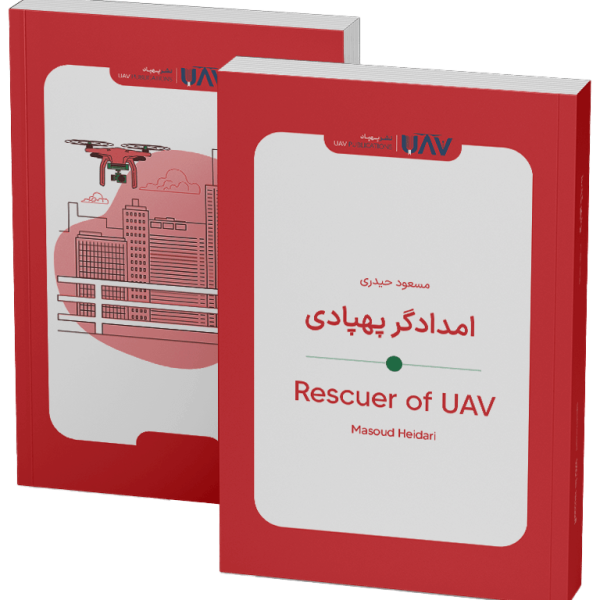Book – Postman of UAV
Postman of UAV, written by Masoud Heidari and published by UAV Publications, is the first Persian-language book dedicated to the transformation of postal and logistics services through drone technology. Written in a fluent and analytical prose, this pioneering work offers a comprehensive exploration of smart aerial delivery systems — from their historical roots to global case studies, from their advantages and challenges to the technologies and skills they require.
Postman of UAV unveils how the future of parcel delivery, healthcare, emergency response, and even environmental monitoring may soar on the wings of these small flying machines. This book is an essential read for professionals in transportation, logistics managers, technologists, students, and all those intrigued by the intelligent future of urban living.
Introducing the Book Postman of UAV
Postman of UAV, authored by Masoud Heidari, is an engaging journey into the innovative world of aerial delivery and postal services powered by drones. Published in 2024 by UAV Publications, this book, written in clear yet precise prose, introduces drone technology to the general public and young enthusiasts alike. The author adeptly demonstrates how UAVs are revolutionizing postal systems, logistics, and even emergency response and healthcare. From the historical evolution of drone tech to its role during the COVID-19 pandemic, from environmental benefits to regulatory challenges, and even the essential skills of a UAV postman—this book covers it all.
A Brief History of Drone Delivery
Contrary to popular belief, drone-based delivery is not merely a recent phenomenon. Its roots trace back to military applications of UAVs in the 20th century. However, the shift to civilian use—mainly in logistics and postal services—began to take serious shape in the 2010s. A key milestone occurred in 2013 when Amazon announced plans to deliver packages via drone. Following that, companies such as Google (via Wing), Zipline, and UPS launched extensive pilot programs worldwide. Rwanda emerged as a true pioneer, utilizing drones to transport blood and medicine to remote regions. Postman of UAV vividly narrates this historical trajectory, showing how drone technology has gradually become an essential component of the modern world.
Advantages of Drone-Based Delivery
Speed, contactless delivery, cost-efficiency, and traffic avoidance are just a few of the many advantages of drone-based logistics. Flying overhead, drones bypass roads, drivers, and congestion entirely. Lightweight packages can be delivered in under 30 minutes. In remote or hard-to-reach areas, there is no need to traverse rugged terrain—drones get the job done in a fraction of the time. Moreover, most UAVs are electric, producing lower emissions and posing less harm to the environment. Drones also prove exceptionally useful in emergencies, such as floods, earthquakes, or public health crises like the COVID-19 pandemic. Postman of UAV provides real-world case studies from various countries, illustrating why a future without drones is increasingly hard to imagine.
Challenges and Barriers in Drone Delivery
Despite the exciting prospects, drone-based postal services face significant challenges. UAVs have limited payload capacities and are best suited for lightweight deliveries. Adverse weather conditions—such as high winds, rain, or snow—can ground them. But the most critical hurdle remains legal and regulatory frameworks. In many countries, there are still no clear, comprehensive policies governing drone flights in urban areas. Privacy concerns, flight safety, and potential interference with other aerial vehicles are pressing issues. The postman of UAV takes a realistic approach in addressing these obstacles and offers possible solutions. By examining the experiences of countries such as the U.S., Switzerland, and India, the book provides a more pragmatic understanding of the path forward.
Core Technologies Behind Postal Drones
Behind every delivery drone lies a sophisticated suite of technologies, including autonomous flight systems, precise GPS navigation, obstacle-avoidance sensors, high-resolution cameras, and high-capacity batteries. To deliver packages accurately, safely, and efficiently, drones must be equipped with advanced hardware and software. Postman of UAV explores these systems in detail, including flight control software, real-time navigation tools, route optimization algorithms, and AI-powered decision-making. The book also introduces readers to emerging technologies such as LiDAR, automated recovery systems, and solar panels in next-generation UAVs—merging science, technology, and futurism in one compelling chapter.
Essential Skills for Drone-Based Logistics
As the world undergoes sweeping changes in transportation and logistics, drones are assuming a central role. But harnessing their full potential requires a specific set of skills. Professionals in this field must be capable of precisely piloting UAVs, understanding aerial navigation principles, and mastering relevant software systems. Route planning, flight data analysis, proficiency in communication technology, and awareness of legal flight requirements are also crucial. In addition to technical expertise, the field demands attention to detail, a sense of responsibility, and adaptability to changing environmental conditions. Familiarity with international standards, safety protocols, and teamwork further strengthens a UAV operator’s profile. The ideal professional in this domain blends technical piloting, data analysis, and operational management.
Corporate and National Roles in Advancing Drone Postal Services
Though initially developed for military use, drone technology is now widely recognized by corporations and governments as a vital tool for lightweight air transportation and postal services. In the U.S., companies like Amazon, Google (Wing), UPS, and Zipline are at the forefront of this transformation. China, leveraging its technological infrastructure and corporate partnerships, has launched large-scale drone delivery initiatives nationwide. Rwanda and Ghana have become global models for developing countries, using Zipline drones to deliver medical supplies to underserved areas. Elsewhere, Switzerland, Australia, India, and the UAE have initiated comprehensive pilot programs. This global movement signals that drone delivery is not merely a technological novelty but an emerging logistical necessity.
Delivery Services in the Age of COVID-19
The COVID-19 pandemic disrupted traditional transportation systems while simultaneously creating an unprecedented opportunity to test new technologies. During this time, drones emerged as highly effective tools for contactless delivery. The surge in demand for human-free service models led to drone-based distribution of medical supplies, vaccines, and hygiene products across many countries. Companies like Zipline in Rwanda, Walmart in the U.S., and Wing in Australia provided successful case studies. Temporary regulatory relaxations enabled faster deployment of these services. This period not only proved the operational efficiency of drones but also significantly increased public awareness and acceptance of the technology.
Different Methods of Drone Delivery
Drone deliveries are executed in various ways depending on package type and destination conditions. A standard method is direct aerial drop—ideal for lightweight items requiring no landing. In some cases, drones land at a designated spot to deliver parcels either manually or automatically. Other strategies include delivery to a dedicated station or landing pad, using robotic arms for loading and unloading, or planning multiple deliveries within a single flight. Each method has its advantages and limitations, chosen based on geography, package type, and safety protocols. What’s clear is that drone delivery systems offer remarkable flexibility, customization potential, and responsiveness to consumer needs.
Environmental Impact of Drone-Based Delivery
One of the most compelling arguments for UAVs in postal and delivery services is their comparatively lower environmental footprint. Electric drones reduce dependence on fossil fuels, decrease air pollution, and alleviate urban traffic congestion, enhancing overall environmental quality. Reduced use of road infrastructure also translates into lower maintenance costs and less wear and tear on the infrastructure. Still, challenges persist, including battery production and disposal, noise pollution, and the conservation of wildlife. Advancing energy-efficient UAVs and improving waste management practices are essential for long-term sustainability. Forward-thinking drone system design must seek to harmonize logistical efficiency with environmental responsibility.
Technological Advancements in the Postal Drone Industry
Innovations in UAV technology are unlocking new pathways for transformation in the postal sector. The integration of advanced navigation systems, artificial intelligence, obstacle-detection sensors, and machine learning algorithms enables drones to deliver with high precision, greater safety, and faster speeds. Key breakthroughs include real-time GPS, LiDAR-based obstacle avoidance, smart cameras, and autonomous flight capabilities. High-endurance batteries and clever cargo compartments further boost operational capacity. These advancements not only enhance service quality but also reduce operational costs and expand the usability of UAVs to remote regions and smart cities alike.
The Role of Artificial Intelligence in Drone Delivery
Artificial intelligence stands as a cornerstone in the evolution of drone delivery services. AI enables UAVs to plan flight paths autonomously, respond to environmental changes, and optimize performance based on prior data. Machine learning algorithms would allow drones to refine their operations, improving accuracy, conserving energy, and reducing error rates. AI also supports air traffic analysis, safe landing site identification, and fleet coordination. These technologies not only accelerate delivery speeds but also ensure safe operations in complex urban landscapes or during emergencies. The future of UAV postal services hinges on deeper integration between intelligent systems and aerial logistics platforms.
Legal and Regulatory Challenges of Drone Delivery
As drone-based services expand, legal and regulatory issues continue to be a significant bottleneck. While many countries have taken steps to draft UAV flight policies, comprehensive and harmonized legal frameworks for commercial drone operations are still lacking. Key concerns include citizen privacy, altitude restrictions, no-fly zones, mandatory permits, and safety standards. In some jurisdictions, drone flights in residential or urban areas are subject to formal registration and require special authorization. Liability in the event of accidents or damage must also be codified. The sustainable growth of drone logistics depends on well-crafted, transparent, and flexible regulatory systems that safeguard public interests while fostering innovation.
Global Experiences with Drone Postal Implementation
Nations around the world have adopted diverse approaches to implementing drone delivery, shaped by their technological and geographic contexts. In the U.S., firms like Amazon and Zipline, in partnership with federal agencies, have conducted extensive trials in medical and postal logistics. China, with its large urban population and domestic UAV manufacturing capabilities, has rapidly scaled its intelligent drone delivery networks. Rwanda and Ghana, using Zipline’s services, have transformed healthcare access in rural zones. In Europe, countries such as Switzerland, Finland, and France are focusing on integrating drones into urban transportation grids. In Asia, India and the UAE are actively piloting UAV initiatives. These case studies highlight that smart policy, private sector engagement, and localized innovation are key to a thriving drone delivery ecosystem.
UAVs in Crisis Response and Emergency Logistics
One of the most potent applications of drones lies in crisis management and emergency relief. In scenarios such as earthquakes, floods, or pandemics, UAVs can deliver vital supplies—such as medicine, food, or emergency gear—to areas unreachable by conventional means.
Their ability to fly independently and bypass damaged infrastructure makes them invaluable during the “golden hour” of rescue operations. A prime example is Zipline’s use of UAVs during the COVID-19 pandemic to transport vaccines and medical supplies to remote villages in Rwanda, Ghana, and the U.S. Drones can also relay live footage from disaster zones, aiding in real-time decision-making. Effective deployment in crises, however, requires robust infrastructure, specialized training, and a sound legal framework.
| Book Author | |
|---|---|
| Book Edition |
First |
| Book Publish Year | |
| Book Publisher | |
| Book Isbn |
978-622-94448-7-0 |
| Book Pages |
70 |
| Book Language |



